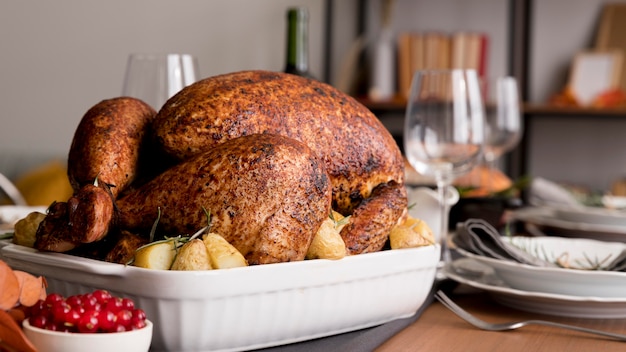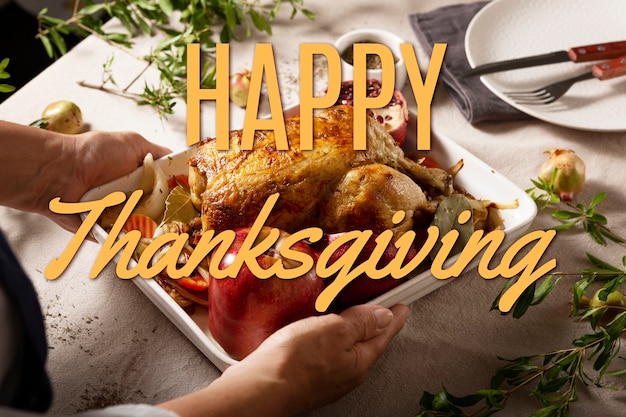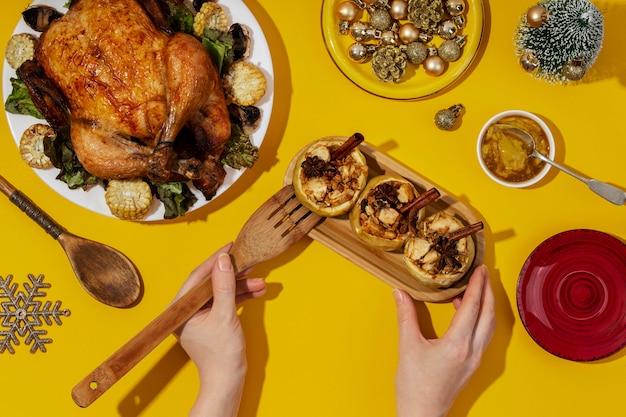(Part 1) Choosing Your Bird

Fresh or Frozen?
Now, we come to a decision point: fresh or frozen. Fresh turkeys are like a culinary indulgence. They’re a bit pricier but they’re the ultimate in flavour and freshness. I love the taste of a truly fresh turkey; it’s like a taste of the countryside. However, they demand a little more planning as you can't just defrost them overnight. frozen turkeys, on the other hand, are great for the organised soul. Just remember to give them ample time to defrost, preferably in the fridge for a safe and thorough thaw.The “Thigh Test”
When picking your turkey, don’t just glance at it; get a feel for it. Give its thighs a gentle squeeze. They should feel firm and springy, like a well-toned muscle. If they feel soft or mushy, it could be a sign that the bird isn’t as fresh as you’d like. Also, keep an eye on the skin. It should be smooth and free from any bruising or discoloration. You want a turkey that looks healthy and vibrant.(Part 2) Preparing the Turkey

The Brine
Here’s where the magic happens. brining a turkey is like giving it a spa treatment, soaking it in a saline solution to keep it juicy and flavorful. I’ve been brining my turkeys for years, and I can tell you, it’s a game-changer. The meat comes out so tender and succulent, the flavors just explode in your mouth. Here’s a simple brine recipe that I swear by: 1 gallon of water 1 cup kosher salt 1/2 cup sugar 1 tablespoon black peppercorns 1 bay leaf 1 teaspoon dried thyme 1/2 teaspoon dried rosemaryMix everything in a large container, then submerge the turkey, ensuring it's fully covered. Pop it in the fridge for 12-24 hours, remembering to flip it every few hours to ensure the brine reaches all corners.Stuffing: The Great Debate
Stuffing: the topic that sparks more debates than Brexit. Some swear by stuffing their turkeys, while others view it as a health risk. I'm a bit on the fence, but I’ve found that stuffing the turkey can make it tricky to cook evenly. It can also take longer to reach a safe internal temperature. So, I recommend stuffing your turkey separately in a casserole dish, just to be safe.(Part 3) Roasting the Turkey

Choosing the Right Pan
You’ll need a roasting pan that's big enough to comfortably hold your 20lb turkey, giving it enough room to breathe and brown beautifully. Make sure it has a rack to lift the turkey up, allowing heat to circulate evenly around it. I also like to use a roasting pan with a lid, so I can baste the turkey without letting precious heat escape.Basting Time
Basting is crucial to achieving that golden-brown, crispy skin and succulent meat. You'll be creating a delicious symphony of flavours. To baste, simply use a spoon to drizzle the drippings from the bottom of the pan over the turkey. Repeat this every 30-45 minutes, showering your bird with love and flavour.Cooking Time
This is where we get into the specifics. A 20lb turkey needs a good amount of time in the oven, about 4-5 hours, depending on your oven. Don’t stress about being glued to the kitchen. Just check the turkey regularly and adjust the cooking time if needed.Temperature Is Key
This is where your trusty meat thermometer comes in. You want the internal temperature of the turkey to reach 165 degrees Fahrenheit (74 degrees Celsius) in the thickest part of the thigh. This ensures it's cooked through and safe to eat. If you don’t have a meat thermometer, I strongly recommend getting one. It’s a small investment that brings peace of mind.(Part 4) Resting the Turkey
The turkey has reached its peak, but we're not quite done yet. It’s time to let it rest, just like a seasoned athlete after a grueling game. Remove the turkey from the oven and let it rest for at least 30 minutes before carving. This allows the juices to redistribute throughout the meat, making it even more tender and succulent.Carving the Turkey
carving a turkey can seem like a daunting task, but it’s simpler than it looks. Follow these steps:1. Place the turkey on a cutting board.2. Remove the legs and thighs.3. Cut the breast meat into thin slices, working your way from one end to the other.Serving Time!
And voila! A beautifully roasted turkey, ready to be enjoyed.(Part 5) side dishes
A Christmas dinner wouldn’t be complete without a symphony of side dishes to accompany the star of the show. Here are some of my favorites:Stuffing
As I mentioned before, I prefer to cook my stuffing separately in a casserole dish. This way, it cooks evenly and safely, without adding any extra stress to your turkey.mashed potatoes
Mashed potatoes are a classic comfort food that pairs perfectly with roasted turkey. Add some butter, milk, and your favorite herbs for an extra touch of indulgence.Cranberry Sauce
Cranberry sauce provides a delightful tangy contrast to the rich flavors of the turkey. You can buy ready-made cranberry sauce, or, for a more personalized touch, whip up your own homemade version.Gravy
Gravy is the ultimate sauce for a turkey dinner. You can make gravy from the pan drippings, capturing the essence of the turkey's flavor, or use a store-bought mix for a convenient option.(Part 6) Troubleshooting
Even the best chefs have their culinary mishaps, and turkey cooking is no exception. Here are some common problems and how to overcome them:Overcooked Turkey
An overcooked turkey results in dry, tough meat. To prevent this, make sure you check the internal temperature regularly and remove the turkey from the oven when it reaches the desired temperature.Undercooked Turkey
An undercooked turkey is a safety hazard. If you’re unsure if the turkey is cooked through, insert a meat thermometer into the thickest part of the thigh. If the temperature is below 165 degrees Fahrenheit (74 degrees Celsius), return it to the oven and continue cooking until it reaches the safe temperature.Dry Turkey
A dry turkey can be caused by overcooking or not basting it enough. If your turkey is dry, you can add some gravy or stock to the pan to help moisten the meat.(Part 7) Leftovers
You’ve enjoyed your magnificent feast, but now you’re left with a glorious mountain of leftover turkey. Don’t let it go to waste! Here are some ideas for making the most of your culinary bounty:turkey sandwiches
Turkey sandwiches are a classic way to repurpose leftover turkey. Add cheese, lettuce, and tomato for a satisfying and delicious lunch.turkey soup
Turkey soup is a comforting and warming meal. Use leftover turkey, broth, vegetables, and noodles to create a heartwarming soup.turkey pot pie
Turkey pot pie is a hearty and satisfying meal. Combine leftover turkey, gravy, vegetables, and puff pastry to create a flavorful pot pie.(Part 8) Tips for a Successful Turkey Roast
To ensure your turkey roasting experience is a resounding success, here are a few extra tips:Plan Ahead
Planning is key to a seamless turkey roast. Gather all your ingredients, equipment, and even your favorite playlist for a festive atmosphere.Don't Crowd the Oven
If you’re roasting other dishes alongside the turkey, make sure you don’t crowd the oven. The turkey needs space to cook evenly and achieve a beautiful golden-brown exterior.Don’t Open the Oven Door
Avoid opening the oven door frequently while the turkey is cooking. This causes the oven temperature to fluctuate and could affect the cooking time.Use a Meat Thermometer
Always use a meat thermometer to ensure the turkey is cooked to the correct internal temperature. It's essential for food safety and guarantees a delicious and tender turkey.FAQs
What is the best way to defrost a frozen turkey?
The safest and most reliable way to defrost a frozen turkey is in the refrigerator. It takes about 24 hours for every 5 pounds of turkey to defrost completely. Make sure to place the turkey on a tray to catch any drips. Avoid defrosting your turkey at room temperature as it can encourage bacterial growth.
Can I reuse the same brine for multiple turkeys?
No, it's not recommended to reuse the same brine for multiple turkeys. The brine becomes contaminated with bacteria from the first turkey, which can make the second turkey unsafe to eat. Always use fresh brine for each turkey.
How long should I roast a 20lb turkey?
A 20lb turkey will take approximately 4-5 hours to roast at 325 degrees Fahrenheit (160 degrees Celsius). The cooking time will vary depending on your oven and the size of the turkey. Always check the internal temperature of the turkey using a meat thermometer to ensure it's cooked through.
What should I do if my turkey is dry?
If your turkey is dry, you can add some gravy or stock to the pan to help moisten the meat. You can also carve the turkey and arrange it on a platter, then pour the gravy over it. The gravy will help to re-hydrate the turkey and make it more flavorful.
What can I do with leftover turkey?
Leftover turkey is a culinary treasure. You can use it to make a variety of delicious meals. Some popular options include turkey sandwiches, turkey soup, turkey pot pie, turkey salad, and turkey tacos. Leftover turkey can also be frozen for later use.
Everyone is watching

Corn on the Cob: The Ultimate Guide to Perfectly Cooked Ears
Healthy MealsAh, corn on the cob. Just the name evokes images of sunny days, barbecues, and that sweet, juicy flavour that ...

Perfect Pork Roast Oven Cooking Time: A Guide to Delicious Results
Healthy MealsThere's something truly satisfying about a perfectly roasted pork. The aroma alone is enough to make your mout...

Ham Cooking Time: How Long to Bake, Smoke, or Boil a Delicious Ham
Healthy MealsAh, ham. It's a classic, isn't it? A real crowd-pleaser, especially around holidays. And when done right, it'...

Scallops: The Ultimate Guide to Perfect Cooking
Healthy MealsAh, scallops. Those delicate, sweet, and utterly delicious morsels of the sea. They hold a special place in my...

Spaghetti Squash: The Ultimate Guide to Cooking and Serving
Healthy MealsRemember that time you saw spaghetti squash at the supermarket, looking all bumpy and strange, and thought, "W...
